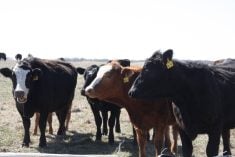This cattle market information is selected from the weekly report from Canfax, a division of the Canadian Cattle Association. More market information, analysis and statistics are available by becoming a Canfax subscriber by calling 403-275-5110 or at www.canfax.ca.
Fed prices down
Alberta fed steers and heifers last week averaged $248.61 and $246.42 per hundredweight, respectively, trading $4.77-$6.41/cwt lower than the previous week. This is the fifth consecutive week that fed price have traded lower.
Read Also

Chinese offer complicates canola marketing
Recently the Chinese ambassador indicated that there would be a potential deal between Canada and China regarding the current tariff war.
The last time the fed price dropped below $250/cwt was 20 weeks ago. Despite the decline, current fed price is holding up better than last summer. Fed prices are down $11.09/cwt from their peak, compared to last year when prices were down $15.11/cwt. Dressed sales were reported at $415-$418/cwt delivered.
The Alberta cash-to-futures basis was reported at +$2.60/cwt, the second strongest for the same week in the last decade. So far in August, basis levels have remained positive; the last time that happened was in 2019.
For the week ending Aug. 10, Canadian fed cattle and cow exports to the U.S. totalled 8,133 head, down 18 per cent from the previous week but remain seven per cent above last year. This is the smallest week over week increase in exports in the last nine weeks.
The Ontario fed steer market has remained steady to stronger over the last seven weeks. Last week fed steers averaged $254.10/cwt. Light dressed sales were reported at $425/cwt delivered, steady with the previous week.
In the U.S., dressed sales in Iowa and Nebraska ranged from US$290-$295/cwt, $3-$8/cwt lower than the previous week. Live sales in the northern feeding states were at mostly $195/cwt, $5/cwt weaker. Sales in Texas and Kansas were at $183/cwt, $3/cwt lower.
Last week, live cattle futures for October, December and February dropped $3-$6/cwt. For the week ending Aug. 3, U.S. steer carcass weights averaged 923 pounds. From their lows in late June, carcass weights have increased 12 lb. For the end of July, carcass weights are record large. For week ending Aug. 10, U.S. cow slaughter at 97,651 head was the lowest since 2016 and down 19 per cent compared to last year. U.S. utility cow prices have been above $141/cwt for the last eight weeks and are 26 per cent above last year.
Cow price steady
Butcher cows traded steady to $2/cwt lower through commercial auction facilities this week. D2s averaged $192.13 and D3s averaged $179.08 per cwt. From their highs in early August, cow prices have dropped $4/cwt.
Dressed prices were all over the map last week with bids/sales reported from $360-$385/cwt delivered. Volumes through commercial auction facilities continue to be light.
Western Canadian cow slaughter for the week ending Aug. 17 totalled 4,359 head, 23 per cent lower than last year. For the middle of August, this is the smallest cow slaughter since 2014.
Over the past 20 years, cow prices have only increased from August to September two times (2004 and 2021). Over the 18 years where prices moved lower from August to September, the average month to month decline was six per cent. Using a historical decline, this would put cow prices on track to average in the low $180s/cwt during September.
Feeders under pressure
Calf and feeder prices were under pressure last week. Since early August, heavier weight feeders over 900 lb. have declined $10-$13/cwt. Feeder cattle weighing over 1,100 lb. seem to be a tough sell. In some instances, 950 lb. feeders are bringing just as much per head as an 1,100+lb. feeder. Larger price slides are being used on heavier weight feeders that are trading via video/electronic sales.
Eastern Canadian buyers continue to be active on heavier weight steer calves. Based on sales held last week, 600-699 lb. steers for October/November delivery traded from $362-$399/cwt with a weighted average price of $380.37/cwt based at 647 lb. Heifers in the same weight range traded from $337-$361/cwt with a weighted average price of $346.26/cwt based at 632 lb.
In August 2023, 600-weight steers for fall delivery averaged $365/cwt, while heifers were at $335/cwt. This suggests steer prices are $15/cwt higher than last year and heifer prices are $11/cwt higher.
The market is not pricing in much of a decline heading into fall as forward delivery prices are close to the spot market.
Cutouts steady
In U.S. beef trade, Choice cutouts closed the week at US$315.99/cwt, up 95 cents per cwt from the previous week. Select was at $302.03/cwt, fully steady.














